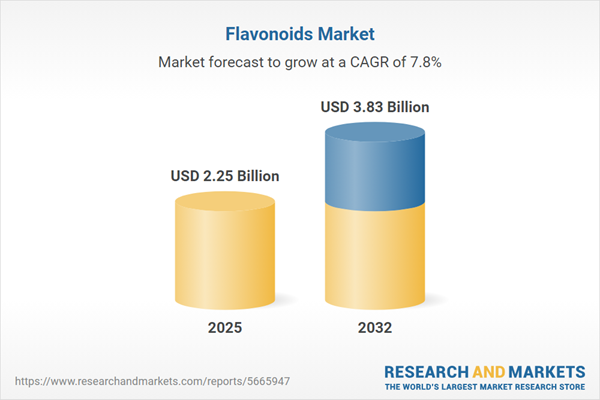Speak directly to the analyst to clarify any post sales queries you may have.
Senior leaders in the flavonoids market must navigate shifting regulations, evolving extraction technologies, and complex supply networks. This report gives a streamlined overview of the competitive landscape and delivers focused, actionable insights for executive decision-makers in the B2B sector.
Market Snapshot: Flavonoids Market Growth and Opportunities
The global flavonoids market reached USD 2.09 billion in 2024 and is projected to rise to USD 2.25 billion by 2025, reflecting steady growth. Market expansion is driven by increasing adoption within health, nutrition, and cosmeceutical applications as organizations seek to differentiate their portfolios. Technological advancements are broadening product offerings, with improved extraction methods enabling tailored solutions that meet the growing demand for plant-based and clean-label ingredients. Companies are modernizing supply chains and sourcing operations to address fluctuating regulatory expectations. Ongoing regional shifts, notably in Asia-Pacific, are redirecting innovation and influencing product uptake in key B2B markets.
Scope & Segmentation: Insights into the Flavonoids Market
- Applications: Flavonoids boost animal nutrition productivity, add value in personal care (skincare, haircare, makeup), and foster functional innovation in dietary supplements, beverages, foods, and pharmaceuticals. Their multi-purpose use supports product diversification in major industries.
- Types: Anthocyanins, flavanols, flavanones, flavones, isoflavones, and neoflavonoids each offer distinct health properties and deliver formulation flexibility, enabling customized solutions across established and emerging segments.
- Form Factors: Available as capsules, powders, liquids, tablets, and gummies, flavonoids integrate seamlessly into diverse manufacturing pipelines and consumer-facing products—enabling rapid portfolio adaptation by executive buyers and procurement teams.
- Source: Sourcing strategies center on plant-based and synthetic flavonoids. Procurement decisions are shaped by traceability needs and regulatory requirements, supporting confidence in ingredient origin and compliance.
- Distribution Channels: Direct retail, e-commerce, and international distribution pathways address a broad spectrum of organizational needs and customer segments, with complex supply networks and evolving region-specific practices.
- Regional Coverage: The market spans the Americas, Europe, Middle East and Africa, and Asia-Pacific. Strategic developments in China, India, and Japan set benchmarks for regulatory adaptation and create expansion opportunities for B2B stakeholders.
- Leading Companies Analyzed: The report benchmarks Indena S.p.A., International Flavors & Fragrances Inc., Givaudan SA, Kalsec Inc., PLT Health Solutions LLC, Koninklijke DSM N.V., BASF SE, Archer-Daniels-Midland Company, Kerry Group plc, and Sabinsa Corporation to support informed strategic decision-making.
Key Takeaways for Senior Decision-Makers
- Clinical research is increasingly validating the efficacy of flavonoids, encouraging deeper investment in research-led product development and collaborative innovation.
- Sustainable sourcing and transparent supply chains are critical for reducing operational risks and building enduring supplier relationships.
- Emerging extraction technologies, including synthetic biology, are lessening dependency on traditional sourcing and enhancing product consistency across applications.
- Effective alignment between R&D and operations accelerates regulatory compliance and speeds new products to market.
- Implementing agile product management systems builds organizational flexibility in response to evolving compliance requirements, reducing risk of costly production delays.
Tariff Impact: Navigating U.S. Tariff Reforms
- Recent U.S. tariff reforms require companies to reassess global sourcing models and production locations to maintain operational resilience in cross-border activities.
- Incorporating natural, synthetic, and fermentation-based production methods helps organizations adapt to frequently changing trade and regulatory environments.
- Strong inventory management, such as selective buffering, fortifies positions against volatile trade conditions and supports steady supply flows.
- Local and offshore processing facility expansion, together with vertical integration, streamlines compliance and helps mitigate regulatory and trade-related risks.
Flavonoids Market Research Methodology & Data Sources
This report draws on direct interviews with industry leaders, stakeholder workshops, in-depth scientific literature analysis, regulatory documentation, patent reviews, and robust market analytics. A multi-source approach ensures the accuracy and relevance of strategic insights for B2B executives in the flavonoids sector.
Why This Flavonoids Market Report Matters
- Senior executives gain targeted benchmarking and structured segmentation analysis, supporting confident procurement and research strategies in a dynamic sector.
- The report’s clear framework positions organizations to anticipate disruptions and proactively identify compliant growth opportunities across the global flavonoids market.
- Findings help align product development, procurement, and regulatory compliance for agile adaptation to evolving stakeholder demands.
Conclusion
This flavonoids market report empowers decision-makers to address evolving industry risks, optimize business strategies, and access new opportunities as global market conditions shift.
Additional Product Information:
- Purchase of this report includes 1 year online access with quarterly updates.
- This report can be updated on request. Please contact our Customer Experience team using the Ask a Question widget on our website.
Table of Contents
3. Executive Summary
4. Market Overview
7. Cumulative Impact of Artificial Intelligence 2025
Companies Mentioned
The companies profiled in this Flavonoids market report include:- Indena S.p.A.
- International Flavors & Fragrances Inc.
- Givaudan SA
- Kalsec Inc.
- PLT Health Solutions, LLC
- Koninklijke DSM N.V.
- BASF SE
- Archer-Daniels-Midland Company
- Kerry Group plc
- Sabinsa Corporation
Table Information
| Report Attribute | Details |
|---|---|
| No. of Pages | 191 |
| Published | October 2025 |
| Forecast Period | 2025 - 2032 |
| Estimated Market Value ( USD | $ 2.25 Billion |
| Forecasted Market Value ( USD | $ 3.83 Billion |
| Compound Annual Growth Rate | 7.8% |
| Regions Covered | Global |
| No. of Companies Mentioned | 11 |









